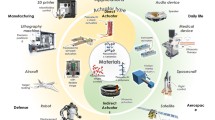Abstract
This article presents the design and control of an ultraprecision XYϑZ stage with nanometer accuracy. The stage has a plane mechanism and symmetric hexagonal structure which consists of a monolithic flexure hinge mechanism with three piezoelectric actuators and six flexures preserving the plane motion. The symmetric design reduces the effect of temperature gradient on the structure. Because the relationship between design variables and system parameters are quite complicated and there are some trade-offs among them, it is very difficult to set design variables manually and optimal design procedure is used. The objective of design is maximizing the 1st resonant frequency to improve the dynamic characteristics. The reason is that the stage must move with heavy load of about 20 kg. The higher resonant frequency also makes the stage stiffer and stronger against the dynamic force and moment. This paper describes the procedures of selecting parameters for the optimal design and a mathematical formulation for the optimization problem. The stage was designed to attain ±10 um in the X- and Y-direction and ±90arcsec in the yaw direction at the same time and have the 1st resonant frequencies of 455.5 Hz in X- and Y-direction and 275.3 Hz for yaw direction without load. The stage was fabricated according to the optimal design results and experimental results indicate that the design procedure is effective. A conventional PI control results are presented for ultraprecision motion.
Similar content being viewed by others
References
Boender, C. G. E. and Rinnooy Kan, A. H. G., 1987, “Baysian Stopping Rules for Multistart Global Optimization Methods,”Mathematical Programming, Vol. 37, pp. 59–80.
Chang, S. H. and Teague, E. C., 1998, “A Precision Piezodriven Micropositioner Mechanism with Large Travel Range,”Rev. Sci. Instrum., Vol. 69, No. 4, pp. 1785–1791.
Chang, Shuo Hung, Tseng, Chung Kai, Chien, Hon Chan, 1999, “An Ultra-precision XYϑz Piezo-Micropositioner Part I: Design and Analysis,”IEEE T. UHrason. Ferr., Vol. 46, No. 4, pp. 897–905.
Eiichi, FURUKAWA, Makoto, MIZUNO, 1992, “Piezo-driven Translation Mechanisms Utilizing Linkages,”Int. J. Japan Soc. Prec. Eng. Vol. 26, No. 1, pp. 54–59.
Elmustafa, A. A. and Lagally, Max G., 2001, “Flexural-hinge Guided Motion Nanopositioner Stage for Precision Machining: Finite Element Simulations,” Prec. Eng., Vol. 25, No. 2, pp. 77–81.
Kang, D. W., Kim, K. H., Jeong, J. H. and Gweon, D. G., 2002, “Miniaturized 1-inch Dual Servo Pick-up Actuator,”proceedings of ISOM/ ODS, pp. 51-53.
Kim, W.-J. and Trumper, D. L., 1998, “Highprecision Magnetic Levitation Stage for Photolithography,”Frec. Eng., Vol. 22, No. 2, pp. 66–77.
Lee, Chang-woo an Kim, Seung-woo, 1997, “An Ultraprecision Stage for Alignment of Wafers in Advanced Microlithography,”Prec. Eng., Vol. 21, No. 2/3, pp. 113–122.
Lee, Sang Heon and Baek, Yoon Su, 2003, “Magnetically Suspended Contact-Free Linear Actuator for Precision Stage,”KSME Int. J. Vol. 17, No. 5, pp. 708–717.
PI catalog, 2001.
Paros, J. M. and Weisbord, L., 1965, “How to Design Flexure Hinge,”Machine Design, Vol. 25, pp. 151–157.
Ryu, Jae W., 1997, “6-Axis Ultraprecision Positioning Mechanism Design and Positioning Control,” Ph.D. Thesis, KAIST, Daejon, Korea, pp. 83-89.
Ryu, Jae W., Gweon, Dae Gab, Moon, Kee S., 1997, “Optimal Design of a Flexure Hinge Based XYϑ Wafer Stage,”Prec. Eng., Vol. 21, No. 1, pp. 18–28.
Shigeo, MORIYAMA, Tatsuo, HARADA and Akihiro, TAKANASHI, 1988, “Precision X-Y Table with a Piezo-driven Fine-table,”Bull. Japan Soc. Prec. Eng., Vol. 22, No. 1, pp. 13–17.
Smith S. T. and Chetwynd D. G, 1992. “Foundations of Ultrapercision Mechanism Design,” Gordon & Breach.
Timoshenko, S. and Goodier, J. N., 1970, “Theory of Elasticity,” 3rd ed. New York: McGraw-Hill.
Yuichi, Okazaki, Shin, Asano and Takayuki, Goto, 1993, “Dual Servo Mechnical Stage for Continuous Positioning,”Int. JSPE, Vol. 27n, No. 2, pp. 172–173.
Author information
Authors and Affiliations
Corresponding author
Rights and permissions
About this article
Cite this article
Kang, D., Kim, K., Choi, Y. et al. Design and control of flexure based XYϑZ stage. J Mech Sci Technol 19, 2157–2164 (2005). https://doi.org/10.1007/BF02916513
Received:
Revised:
Issue Date:
DOI: https://doi.org/10.1007/BF02916513




